Configuring Remote Connection Settings
PAM360 offers advanced configuration settings for remote connections added to it. Use these settings to customize SSH, RDP, and VNC connections, thereby improving the overall user experience while initiating remote sessions from PAM360 to the respective remote resources. Some of the advanced settings include changing the SSH terminal type, modifying the desktop composition for RDP connections, changing the encoding type of VNC connections, etc. PAM360 provides a centralized configuration that unifies the functionalities of SSH, RDP, and VNC connections for ease of use. Remember, all the changes to the settings made here will be applied locally to the remote resources as well.
You will learn the following topics in this document:
- Steps to Configure
- Connection Settings for Different Connection Types
- Glossary of Terminologies and Definitions
1. Steps to Configure
Use the below steps to configure Connection Settings either for an individual account or for multiple accounts in bulk:
- To configure Connection Settings for an individual account:
- Navigate to the Resources tab and switch to the Passwords tab. Here, click the Account Actions dropdown beside the required account and click Connection Settings in the dropdown. Connection Settings options for the selected account type (SSH/RDP/VNC) alone will open up.
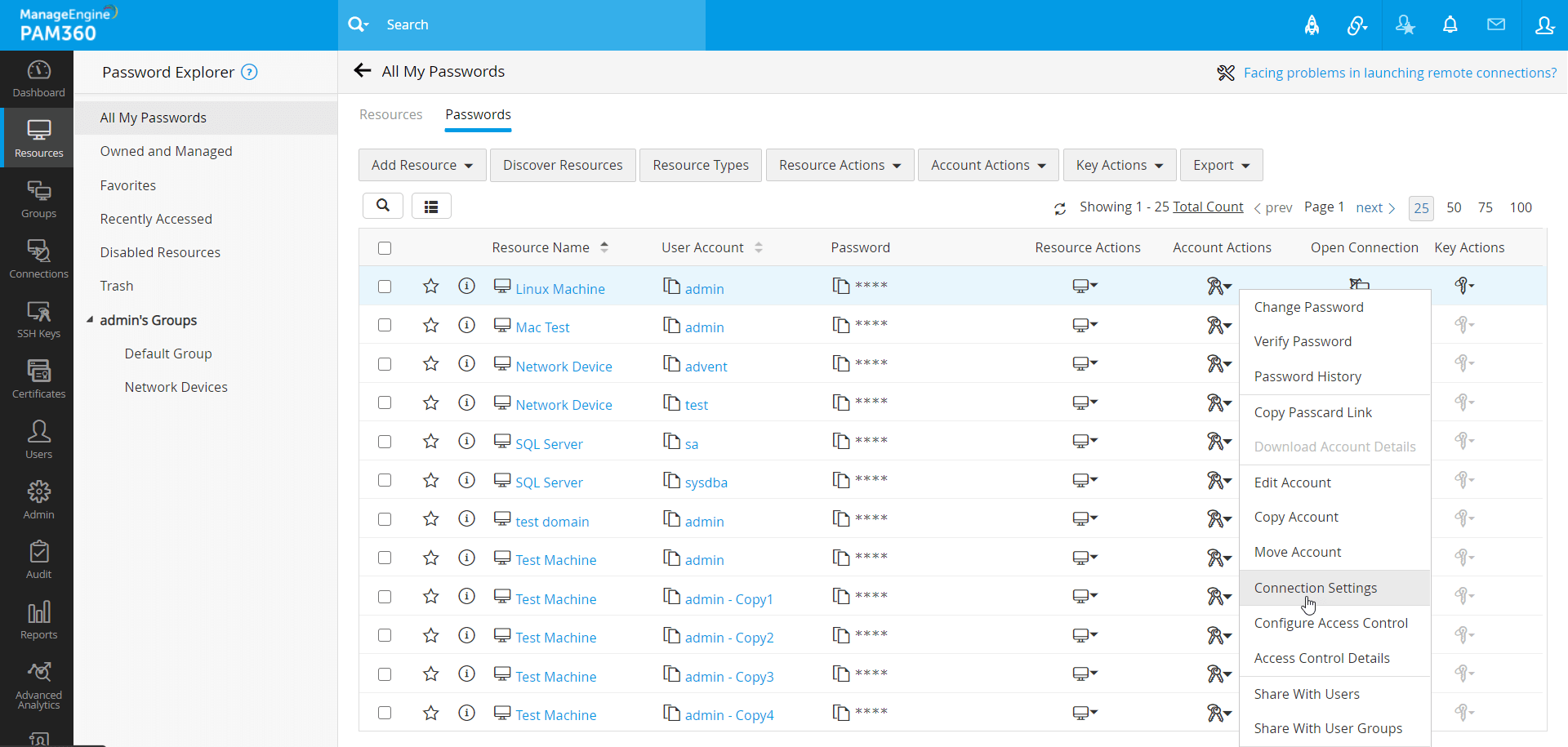
- Navigate to the Resources tab and switch to the Passwords tab. Here, click the Account Actions dropdown beside the required account and click Connection Settings in the dropdown. Connection Settings options for the selected account type (SSH/RDP/VNC) alone will open up.
- To configure Connection Settings in bulk:
- In the Passwords tab, select a number of accounts using the check-boxes, click the common Account Actions dropdown at the top and click Connection Settings in the dropdown. In this case, Connection Settings options for all three types of accounts will open up to facilitate applying settings for multiple accounts in bulk.
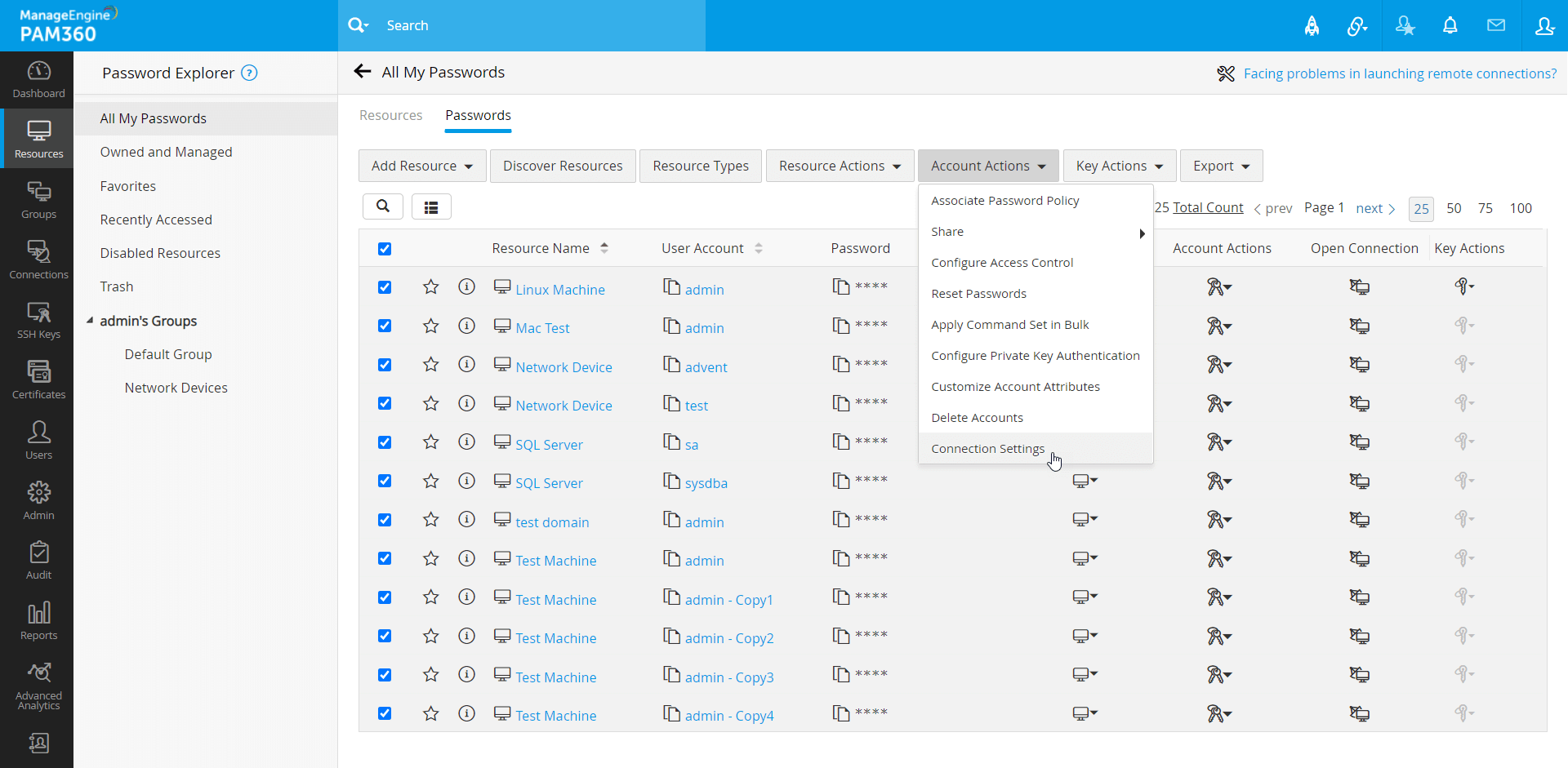
- To apply Connection Settings for a group of accounts within a particular resource, switch to the Resources tab and click the name of the required resource. All accounts added under this resource will be displayed in the Account Details dialog box. Here, either click Account Actions beside particular account or select multiple accounts using the check-boxes and click the common Connection Settings option available at the top. Any connection settings applied here will be confined to the accounts of the selected resource only.
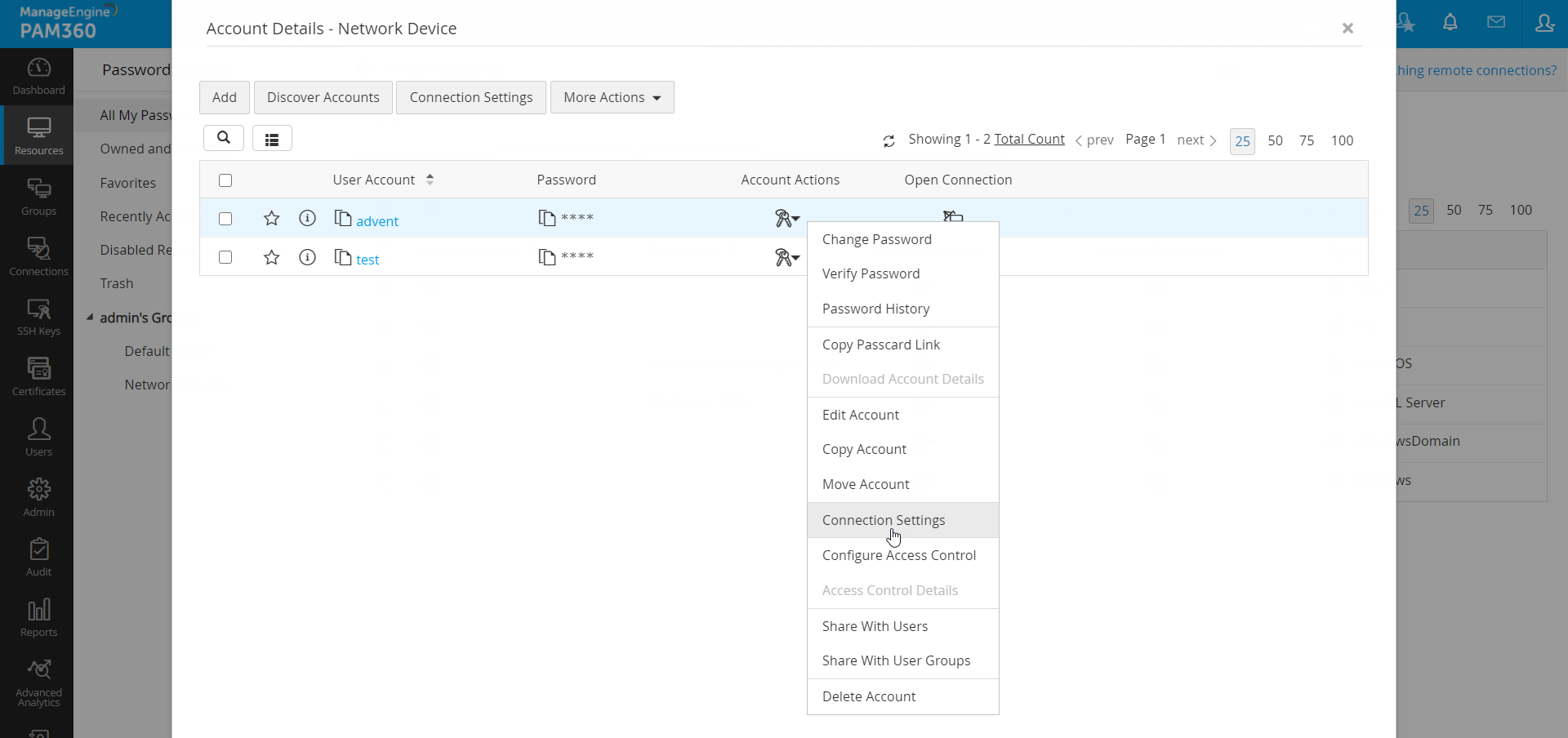
- In the Passwords tab, select a number of accounts using the check-boxes, click the common Account Actions dropdown at the top and click Connection Settings in the dropdown. In this case, Connection Settings options for all three types of accounts will open up to facilitate applying settings for multiple accounts in bulk.
- To configure Connection Settings for a group of resources:
- Navigate to the Groups tab. Click the Actions dropdown beside the required resource group name and click Connection Settings in the dropdown. Connection Settings options for all three types of accounts will open up to facilitate applying settings for all the accounts within the selected resource group. Click here to learn more about how to add resource groups in PAM360.
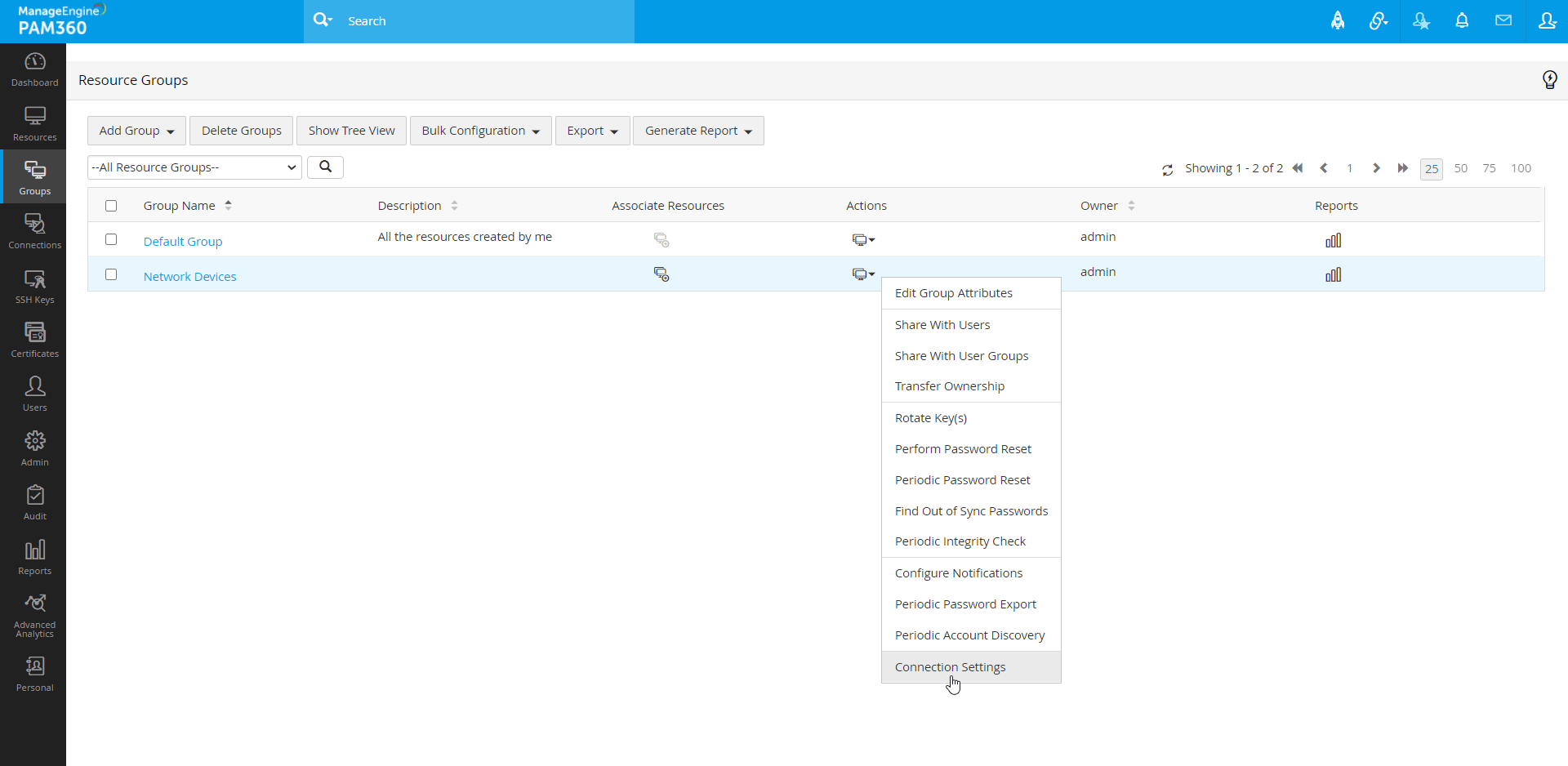
- There are three types of connections for which PAM360 offers Connection Settings. Click the links below for a detailed explanation for each type and a glossary of terminologies used in the document:
2. Connection Settings for Different Connection Types
2.1 SSH Connection
Typically, terminal types and corresponding sets of commands vary from one SSH device to another. For example, if the SSH device added to PAM360 is IBM AS400, but the terminal type is a Linux terminal type, say 'xterm', a few commands will not work as expected, thereby reducing the efficiency considerably. Hence, it is essential to define the exact terminal type for each SSH device added to PAM360 so that PAM360 can emulate the terminal and be prepared to process the types of commands used on that particular terminal. All you need to do is to type in the name of the Terminal Type in the text field for the selected SSH device and click Save.
Click here for a brief list of terminal emulators.
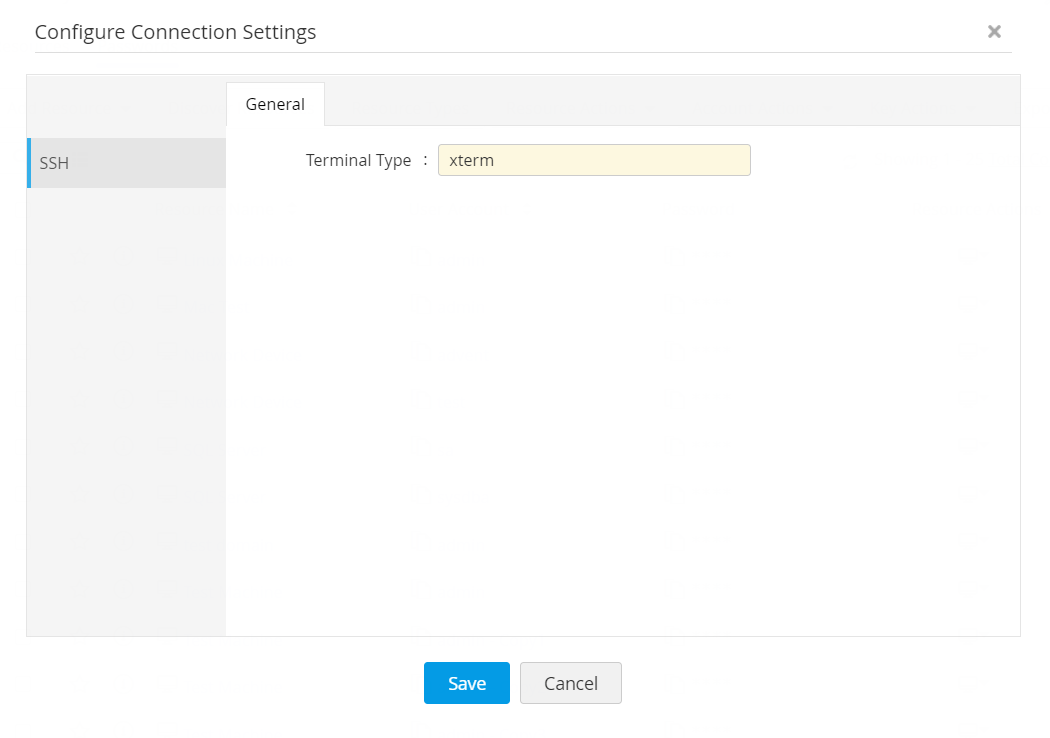
2.2 RDP Connection
As shown below, the connection settings for remote sessions launched using RDP are organized into four sections:
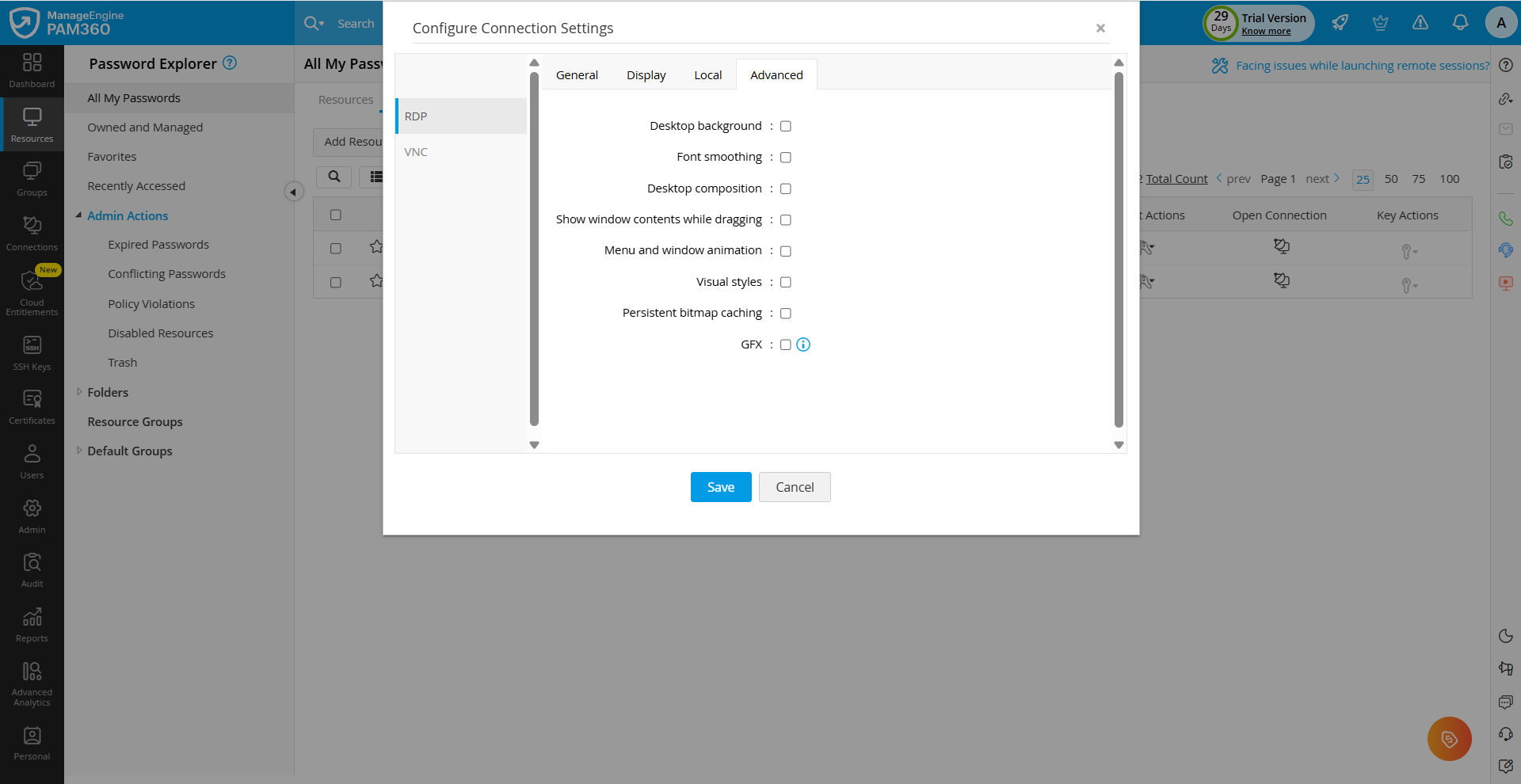
- General
- Connect to console session - Enable this checkbox to initiate a console session to the remote machine.
- If a regular remote session is active on a target machine (Windows Client Edition), starting a console session will disconnect the existing user session and start a new console session.
- If the target machine is a Windows Server, the console session will get initiated with the regular remote session using a CAL (Client Access License) without disrupting other user sessions.
- Display
- Color depth - Choose the desired color depth from the displayed options.
- Disable remote cursor - Enable this checkbox to hide the remote computer's mouse cursor from your screen during the RDP session.
- Local
- Remote audio playback - Select how audio from the remote machine should be played during the RDP session playback.
- Quality - Adjust the visual quality of the remote session to balance performance and display clarity.
- Clipboard - Enable this checkbox to share data between the local and remote machines through clipboard redirection.
- Printer - Enable this option to allow printing from applications running on the remote computer to your physical printers, redirecting your local printers.
- Printer Name - Specify the name of the local printer to be used for printing from within the remote session if local printer redirection is enabled.
- Drives - Enable this checkbox to facilitate secure file transfer between your local machine and the target machine.
- Text Only - Enable this checkbox to disable the graphical elements on the remote session and improve session performance over low-bandwidth connections.
- Advanced - These are settings related to visual enhancements and performance optimizations. Click here to view Microsoft's documentation for detailed information about the various options displayed in this section.
- When the GFX option available under the Advanced tab is enabled, the visual experience of remote sessions are enhanced by offloading graphics processing to the GPU on the remote host or by optimizing the bandwidth and image quality using advanced codecs, resulting in smoother visuals, improved performance, and support for high-quality remote desktop experiences.
Notes:
Note: Higher color depths result in vibrant output but at the cost of increased bandwidth, which can impact network performance on slower connections.
Note: When the GFX option under the Advanced tab is enabled, for proper rendering of the RDP session, ensure the Prioritize H.264/AVC 444 graphics mode for Remote Desktop Connections and Enable H.264/AVC 444 hardware encoding for Remote Desktop Connections policies are enabled under the RDP group policy settings. If these policies are disabled, the connection will be established, but the screen will appear blank.
To configure the keyboard layout for remote sessions, navigate to General Settings >> Remote Session Management and choose a language from the Keyboard Language dropdown. The selected language applies to all the users in the PAM360 environment. The default language settings will be applied if a keyboard language is not configured.
Note: Users can select their preferred keyboard language for remote sessions in the Remote Session Settings window, which can be accessed by clicking the My Profile icon. The selected keyboard language will apply only to remote sessions initiated after the configuration.
2.3 VNC Connection
For VNC sessions, use the following settings to enhance the user experience and also enforce some controls over the remote sessions. Choose an encoding format from the available list: ZRLE/Raw/Tight/Hextile/CopyRect. Also, choose how to display colors, the JPEG quality, and the extent to compress the ZIP files. Additionally, you can disable the remote cursor/switch on the tracker for the cursor on the local machine.
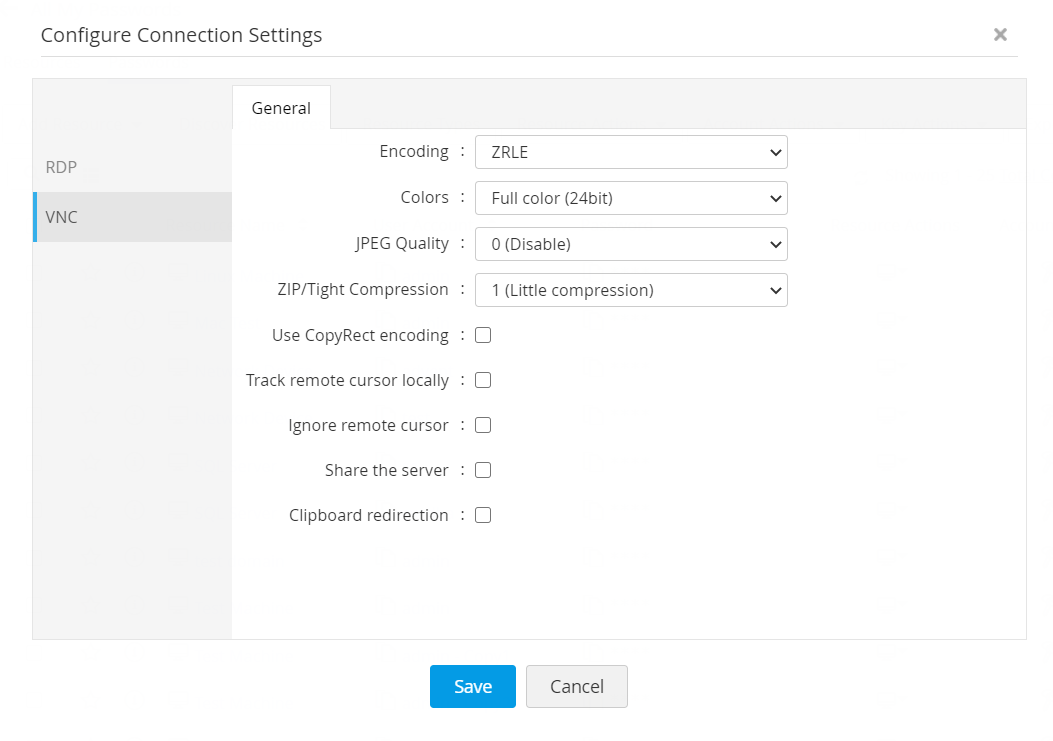
3. Glossary of Terminologies and Definitions
| Term | Definition |
|---|---|
ZRLE |
ZRLE stands for Zlib Run-Length Encoding . It is considered to be best for low-bandwidth network environments. |
Raw |
The raw encoding sends width*height pixel values. Raw encoding minimizes processing time and increases connection speed when the server and VNC viewer are on the same machine. |
Tight |
Tight encoding is considered to be the best choice for low-bandwidth network environments such as e.g. slow modem connections. Tight encoding uses zlib library to compress raw pixel data, but it pre-processes data to maximize compression ratios and to minimize CPU usage on compression. JPEG compression may be used to encode color-rich screen areas. |
Hextile |
Hextile encoding is considered to be the best choice for high-speed network environments such as Ethernet local-area networks. |
CopyRect |
Copy Rectangle or CopyRect encoding is useful when data is being moved; the only data sent is the location of a rectangle from which data is to be copied to the current location. |